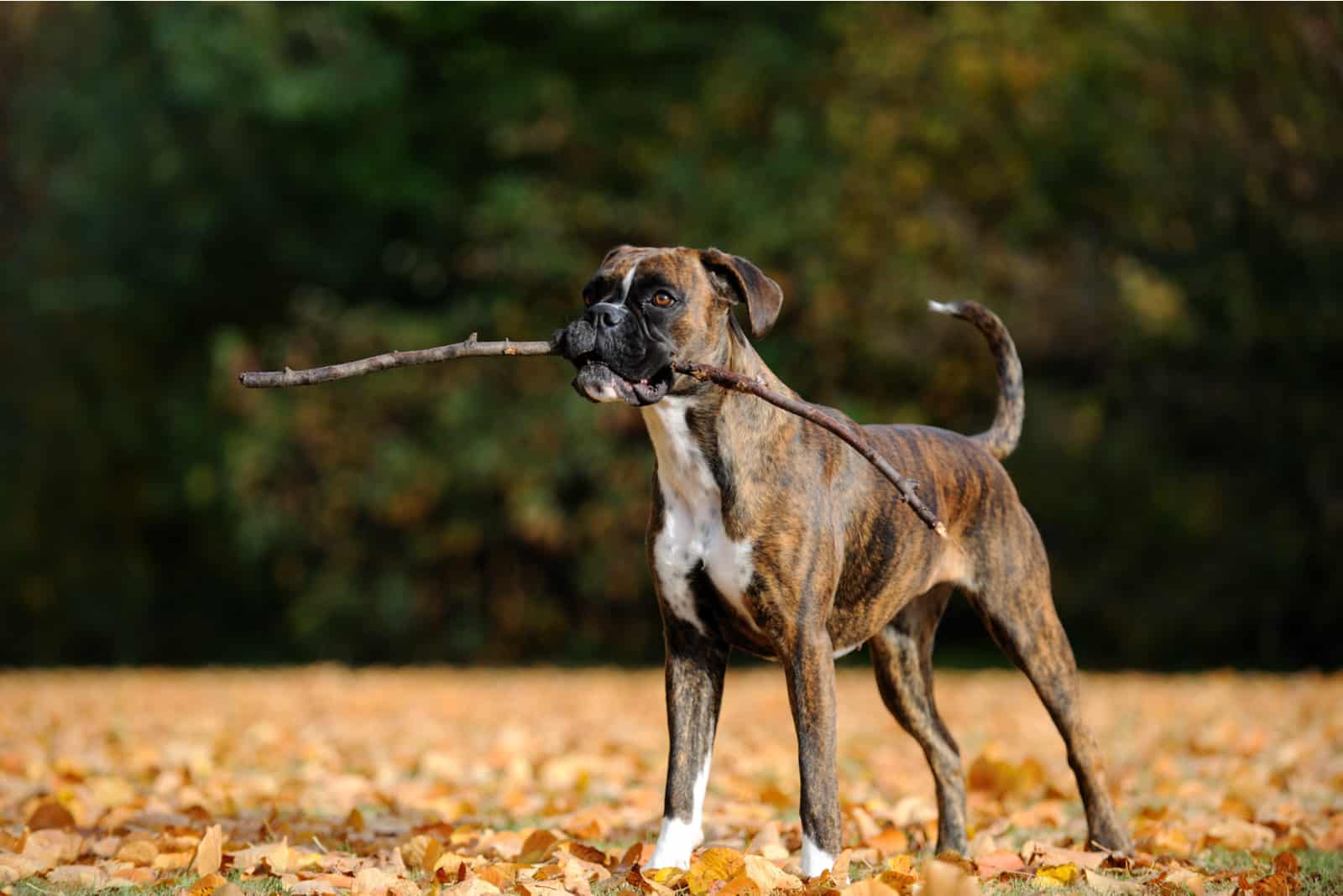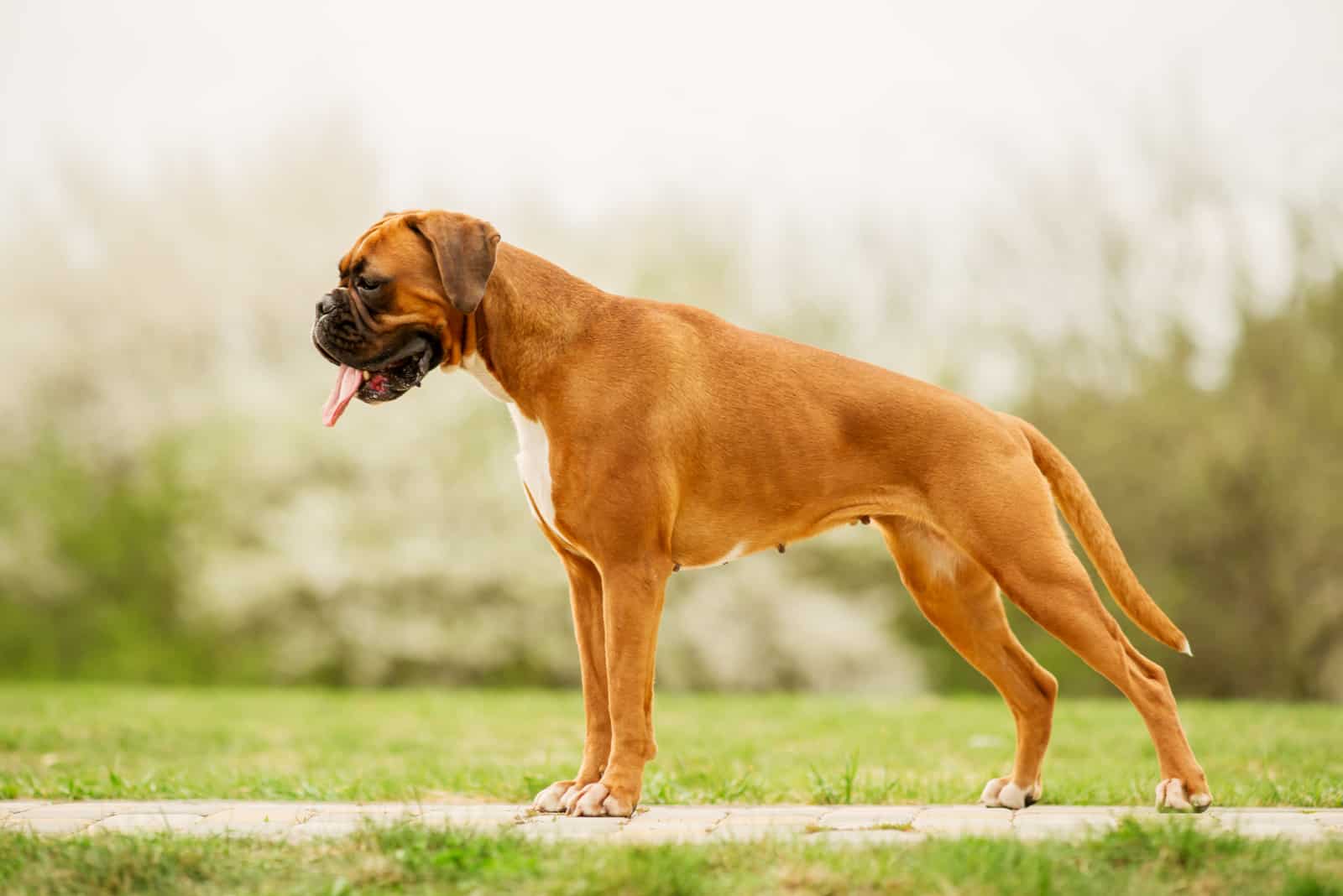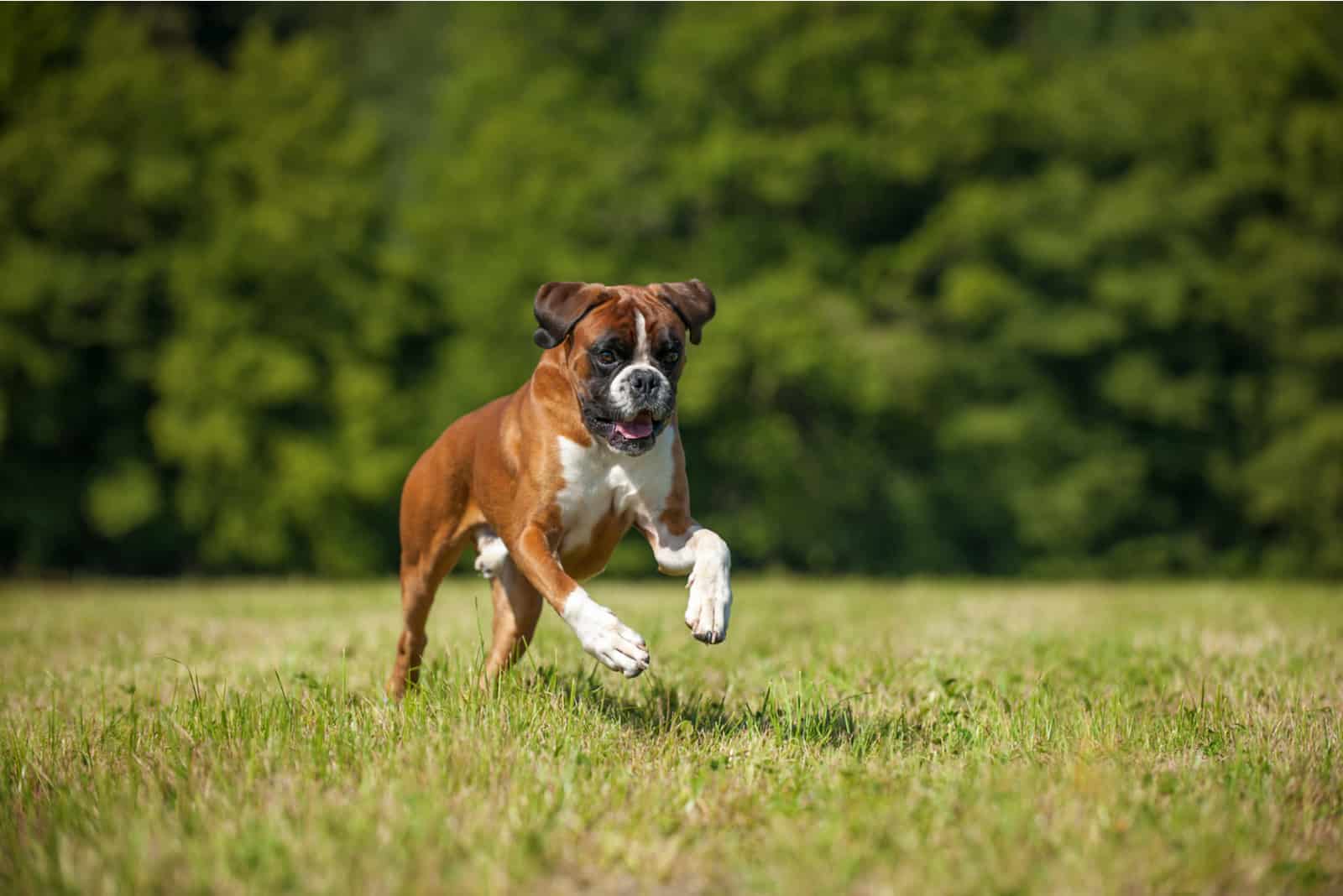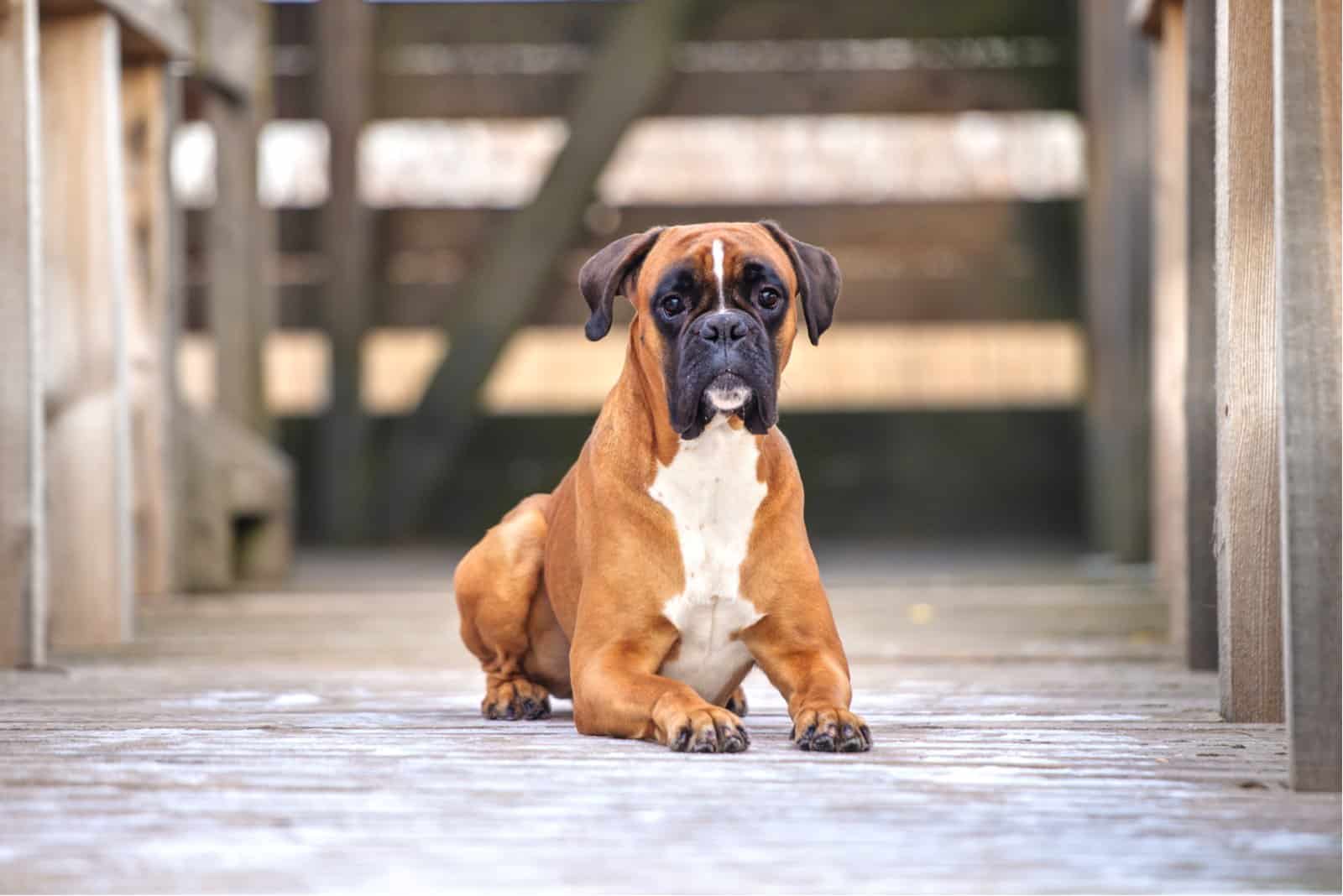Despite their large and muscular body that might seem intimidating, Boxer dogs are one of the noblest and dearest dog breeds. If you have a Boxer, you are safe with your protector and your life companion at the same time.
The American Kennel Club (AKC) describes Boxer dogs as very active and fun-loving.
This purebred dog used to be a hunting dog, so he needs to be busy all the time. He is a big fan of children and could spend all of his time outdoors playing with his human family.
Boxers have a lot of energy and need daily exercise, but if you are ready to spend a lot of your free time teaching your furry friend various tricks, these dogs are very trainable and learn fast.
If you just welcomed a Boxer puppy into your home or are planning to do so shortly, I am sure you are asking yourself: How tall will my Boxer get? Is he going to become a medium-large or a really large dog?
To resolve all of your dilemmas regarding your Boxer’s size, today we bring you the Boxer growth chart explained. Continue reading and find out how big your Boxer will get at all stages of his development. Also, learn more about what your dog’s size might be telling you about his health.
Boxer Growth Chart
Why will the Boxer growth chart be useful to you?
The Boxer is usually described as a medium-large or large breed dog.
You should be familiar with the growth rate of the dog breed you possess. This way you will know how to properly prepare for each subsequent stage of growth, how much food your pet will need, and how fast your dog should progress.
There are certain differences in growth between male Boxers and female Boxers, so, let’s look at what the values in the Boxer puppy growth chart are showing us.
[table id=451 /]
When they’re born, there is no difference in the size between male and female Boxers. However, from the age of 5 months onwards, male Boxers are usually bigger than females.
This chart of course shows the average height for Boxer dogs for each developmental stage: this does not mean that your Boxer is not growing properly for age if you notice a slight deviation from this graph.
Boxer Weight Chart
The weight chart of your Boxer is equally important as the height chart. So, let’s find out what the average weight of your Boxer should be for each developmental stage.
[table id=452 /]
By 6 months of age, Boxer dogs progress a lot in their weight, as you can see on the Boxer puppy weight chart.
If your dog’s weight doesn’t exactly match his age range according to the Boxer weight chart, there’s no need to worry right away.
Make sure you have all of your dog’s health records from the breeder. Also, as long as you take your dog to vet check-ups regularly, and if the dog has received all the necessary vaccines for his age, you can be sure that your dog is healthy.
However, an alarm could be triggered if you notice that your dog has problems with obesity or if he is underweight. In that case, it is necessary to find the reason for the inappropriate weight and work to solve this problem as soon as possible.
What Is The Average Weight Of A Boxer?
A fully grown male Boxer weighs between 65 to 80 pounds. The adult weight of a female Boxer goes from 50 to 65 pounds on average.
However, various factors significantly affect the average weight and height of a Boxer, so there might be some deviations from the average weight and height of these dogs. We will explain the factors affecting Boxer Growth in detail below.
But, let’s first find out how a Boxer dog changes throughout its growth stages.
Boxer Puppy Developmental Stages

You’ve just welcomed a Boxer puppy into your home and are not sure what to expect? How big is your pet friend going to be? Let’s start from the beginning.
Birth-Two Weeks
When they are just born, all that Boxer puppies do is eat and sleep. In this stage, puppies do not have teeth and are deaf and blind.
In this early period, mother’s milk is crucial for the physical and mental development of a Boxer puppy.
However, this stage is not passive for Boxer dogs. Boxer puppies usually weigh around 3 pounds when they are born. At the end of their second week of life, their average weight is between 4 and 5.5 pounds.
Therefore, this growth stage presents a rapid growth stage for Boxers.
Two Weeks-12 Weeks
Being a large dog breed, Boxer dogs need a lot of food so they can grow accordingly. If you are used to having a small dog, be ready to give a lot more food to your new pet!
When these dogs are around 4 weeks old, they start to eat solid food. During this period, they gain a lot of weight, so it is necessary to be careful not to exaggerate with the dog food.
By the time they are 4 weeks old, Boxer puppies gain teeth and also develop a sense of hearing and open their eyes. When they are 5 weeks old, Boxer dogs start to show the urge to socialize and need their playtime.
At the stage between 6 and 8 weeks, your puppy should start with his first vaccinations. When they are 8 weeks old, Boxer puppies are ready to leave their mothers and go to their new homes.
In the next stage, when Boxer puppies are from 9 to 12 weeks old, dog owners will enjoy them the most, since this is the period when these dogs are ready to learn some basic tricks and commands.
At the end of this period, both male and female Boxer puppies should be around 12 inches tall, according to the breed standard.
Three Months-Six Months

This is the period when your new puppy starts to explore the world. In this stage, it is extremely important to introduce your Boxer to new places and new people. This is the best way to properly socialize and train your dog.
In terms of weight for this stage, a healthy weight for a Boxer at 5 months is between 33 and 40 pounds.
As to height, a 6-months old Boxer should be around 18 inches tall at 6 months.
Six Months-24 Months
Compared to some smaller breeds, you sometimes might think that your Boxer is not acting according to his age. But you don’t have to be worried! Larger dogs or medium-sized dogs such as Boxers reach maturity in later stages than some smaller dogs.
At the end of the dog’s growth stages, you can expect your Boxer to be around 21 to 25 inches tall, while his weight should be between 50 to 80 pounds.
At What Age Is A Boxer Fully Grown?
You might have to wait a while until you have an adult Boxer in your home!
Most dogs of the Boxer breed reach their adult size when they are around 1 year old. However, some of these dogs continue to grow, so, according to the Boxer growth chart, these dogs will reach their full height and full body weight at the age of 18 to 24 months.
If you notice sudden weight gain or weight loss after the growth period of your dog should have finished, it is necessary to check your dog’s health condition immediately. Changes in the dog’s weight might point to certain health problems.
According to some opinions, it takes up to three years for Boxer dogs to reach their full maturity! So, be prepared to enjoy a long period of childhood behavior from your dog friend.
What Is A Boxer’s Life Expectancy?
A Boxer’s lifespan is estimated to be from 10 to 12 years. Larger dogs usually have a shorter life expectancy than smaller dogs, and we are not quite sure yet what is the main reason for this.
However, we should not get discouraged because there is always something all dog owners can and should do: take the best care of their pet’s lifestyle and nutrition, and take them for regular vet check-ups.
What Factors Affect Boxer Growth?

If you are well acquainted with the Boxer growth chart, you will be able to provide your dog with the lifestyle he needs to have to become a happy and healthy dog.
A couple of factors might significantly affect the growth of your Boxer. Let’s find out which are the most important ones.
Genetics
Genetics is very important for your dog in general, as it largely determines the appearance and behavior of a dog. If you are buying your dog from a responsible breeder, he will most likely inform you about your dog’s parents and grandparents, their health, appearance, and everything else you should know.
Some Boxer breeders also show you pictures of your dog’s parents so you can immediately get an insight into what your dog will look like when he grows up!
If this information is not available to you, you can always have a DNA test done that can help you find out how big your dog might get.
RELATED: 50 Boxer Mixes: Unique Boxer Cross Breeds You Didn’t Know Existed
Exercise
Every Boxer needs intense training daily. Going for a walk, running around the yard or any other activity is always welcome to help your Boxer spend the tremendous energy he possesses.
Although exercise is essential for this dog, it is important to make sure that exercise is not overdone. This is especially important in the early stages of a dog’s growth. If a Boxer gets too much exercise before his bones and joints are properly developed, this could negatively affect his further growth.
Nutrition
Since Boxers are bigger dogs, they need a lot of quality food to develop properly. However, every Boxer owner must be extremely careful here.
The food your Boxer gets should be full of vitamins and minerals, but you should not overdo it with the amount of food. Two meals a day is quite enough for a Boxer, so try not to leave food out for your dog outside of these two feedings. This way, the dog will learn his routine and will not look for extra food.
Boxers are dogs that easily become obese, so proper feeding habits need to be instilled at an early age.
The Boxer feeding chart will provide you with more useful information on this dog’s nutritional needs.
Bottom Line

We know that all dog owners sometimes wonder if their pet is at the right weight and height according to their age.
To make it easier for you to answer these questions, we have described the Boxer growth chart in this article. By following this chart, you can conclude whether your dog is in the average weight and height range that corresponds to his age.
If you notice minor deviations, do not stress! Various factors affect the growth process of your Boxer, and, remember, some Boxers continue growing even after their second year of life.
All you as a responsible dog owner need to do is provide your dog with enough love, exercise, quality food, and regular visits to the vet. This way, your Boxer, without any doubt, will grow into a healthy and big dog!
READ NEXT:
• European Boxers – Are They Different Than American Boxers?
• English Mastiff Growth Chart – How Big Do They Get?
• Why Boxers Are The Worst Dogs — 8 Challenges Of Boxer Owners
